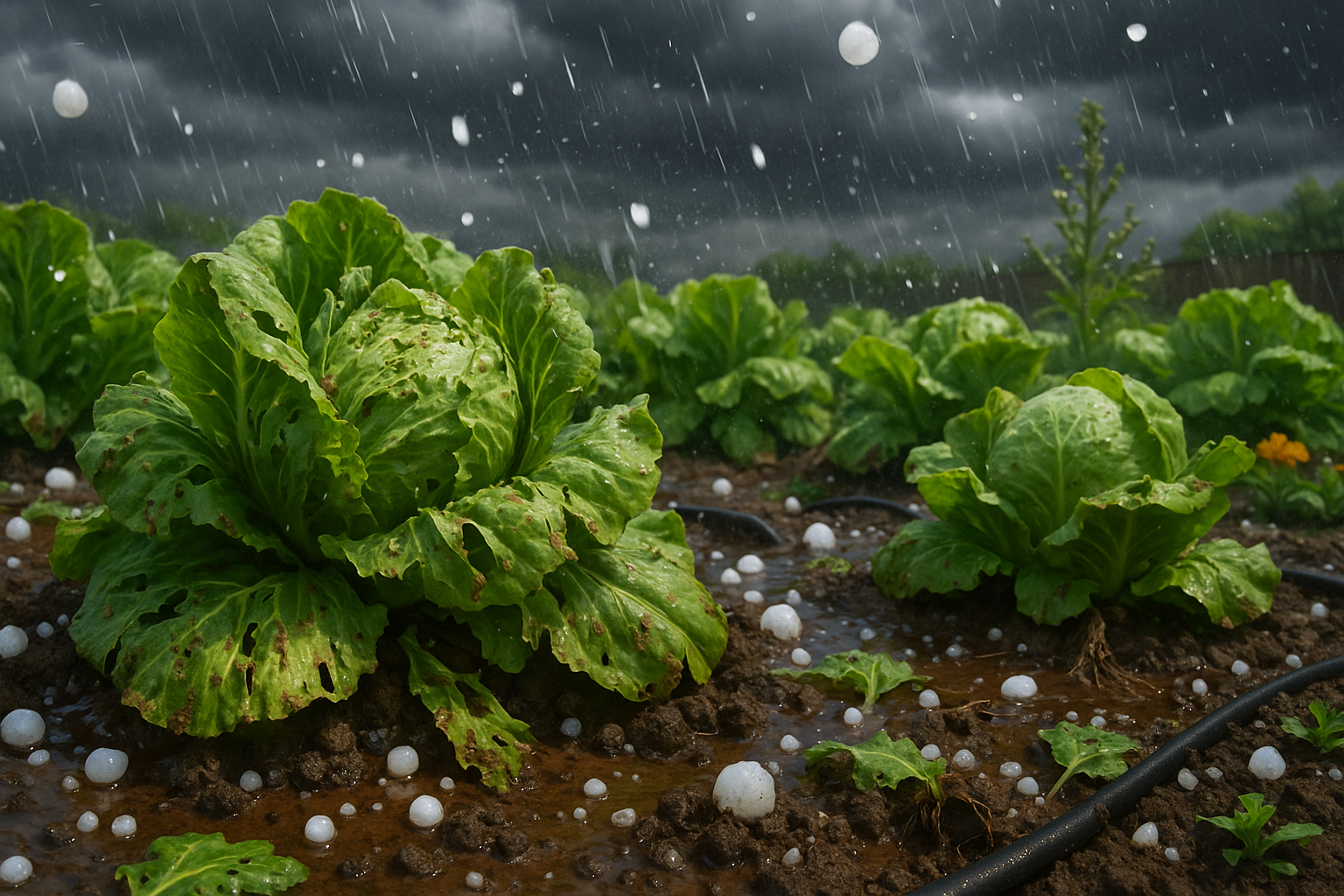Understanding the Impact of Heavy Rain and Hail on Lettuce
Heavy rain and hail can wreak havoc on lettuce crops, leaving visible bruising, tearing, or even shredding the delicate leaves. Because lettuce has such thin and tender foliage, it’s more vulnerable to physical injury than sturdier greens like kale or collards, which can bounce back from weather events with less damage.
Bruises from pounding rain or hailstones are often the first sign, quickly followed by ragged edges or holes where leaves have been torn. Beyond just cosmetic injury, heavy downpours can cause soil erosion, washing away nutrients and leaving roots exposed or plants partially uprooted.
When soil remains saturated for prolonged periods, lettuce—already prone to rot—becomes a magnet for fungal and bacterial diseases such as bottom rot and downy mildew. This risk is higher than in greens with thicker cuticles or waxier leaves since fragile lettuce tends to retain moisture and doesn’t repel water well.
For both home and market gardeners, these vulnerabilities make protecting lettuce with row covers or proper drainage essential, especially during peak growing seasons.
After storms, growers often notice telltale problems in their lettuce beds:
- Soft, mushy spots on leaves
- Slimy yellow or brown patches
- An unmistakable wilt that often signals root decay
Sometimes entire heads collapse or get overtaken by disease within days of a weather event. By keeping an eye out for these issues and taking prompt action—like removing damaged leaves and improving airflow—gardeners can help salvage their lettuce and prevent widespread loss.
Choosing the Right Location for Your Lettuce Garden
Finding the perfect spot for your lettuce garden can make all the difference, especially when dealing with unpredictable weather like heavy rain or hail. Microclimates—those little pockets where temperature, moisture, and wind differ from the surrounding area—are key to consider.
For example, a spot shielded by a fence or hedge may get less damage from hail, while a south-facing slope usually warms up faster in spring. This gives young lettuce a head start and helps excess moisture drain away more quickly.
Avoid setting up your garden in low-lying areas since these spots tend to collect cold air and water, making your lettuce more vulnerable to flooding or root rot during storms. Instead, aim for higher ground and, if possible, tuck your lettuce under the partial protection of a tree canopy or near tall shrubs. These can help buffer intense rain and hail without blocking too much sunlight.
Raised beds or large containers are also excellent choices—they lift your plants above soggy ground and make it easier to control soil drainage, reducing the chance of waterlogged roots. In urban settings, even a balcony can become a successful lettuce patch if you use containers and pick a spot shielded from the harshest weather.
By paying attention to microclimates, site slope, and drainage, you’ll give your lettuce the best shot at thriving, no matter what the forecast brings.
Physical Barriers
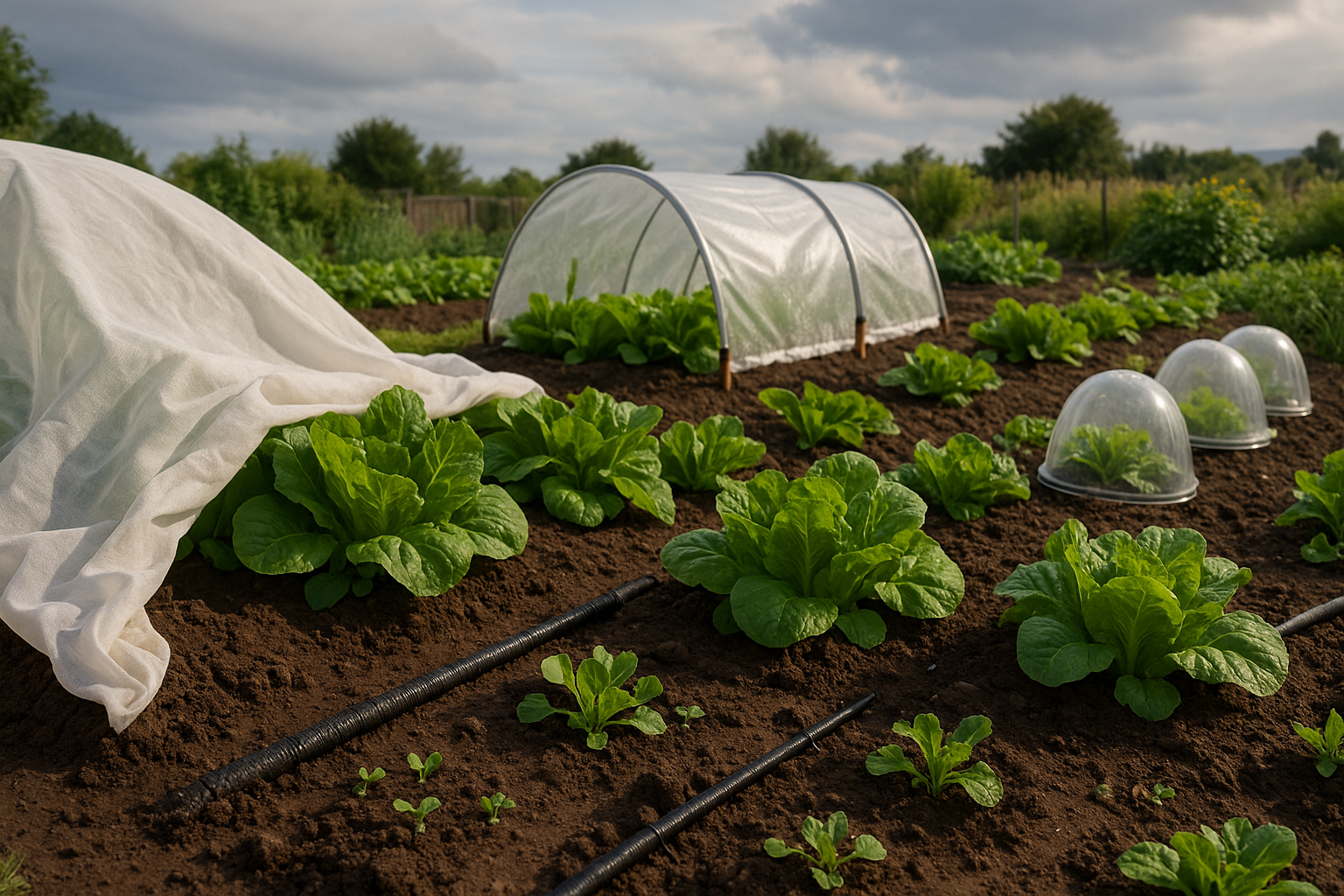
Protecting your lettuce from harsh weather, pests, and temperature swings is simple and effective with the right physical barriers. Floating row covers are one of the most popular options: these lightweight fabrics, typically made from fleece or spunbonded polypropylene, can be draped directly over your lettuce beds to create a cozy microclimate.
For quick coverage, simply unroll the fabric, lay it loosely across your rows, and secure the edges with garden staples, soil, or rocks—no specialized tools needed. These covers protect against frost and insects. For added durability and wind resistance, look for thicker fleece or reinforced polypropylene.
As an alternative, low tunnels—created by arching hoops over the bed and stretching plastic sheeting or mesh across the top—offer sturdier protection. Plastic sheeting is great for retaining warmth and shielding from heavy rain, but it can cause overheating, especially on sunny days. Mesh, on the other hand, is breathable and excels at keeping insects away without trapping excess heat.
Installation is quick: insert hoops (metal, plastic, or flexible PVC) every few feet, pull your chosen covering material taut, and clip or secure it to the hoops. Before storms, make sure the ends of your tunnels are well anchored to prevent wind from lifting the cover.
Cloches—individual plant domes made from clear plastic or glass—work well for isolated plants or smaller patches. Simply place them over lettuce before a storm strikes. For larger plantings, small hoop houses—essentially miniature greenhouses—offer robust, reusable protection but require a bit more setup.
Whichever method you choose, remember to regularly check your lettuce, especially in spring and early summer. On sunny days, lift or vent the covers to prevent overheating or excess humidity, and remove them entirely once the danger has passed or when pollinators need access.
With these tools in your gardening arsenal, you’ll keep your lettuce safe through spring squalls, cold snaps, and surprise summer storms.
DIY Solutions for Emergency Storm Protection
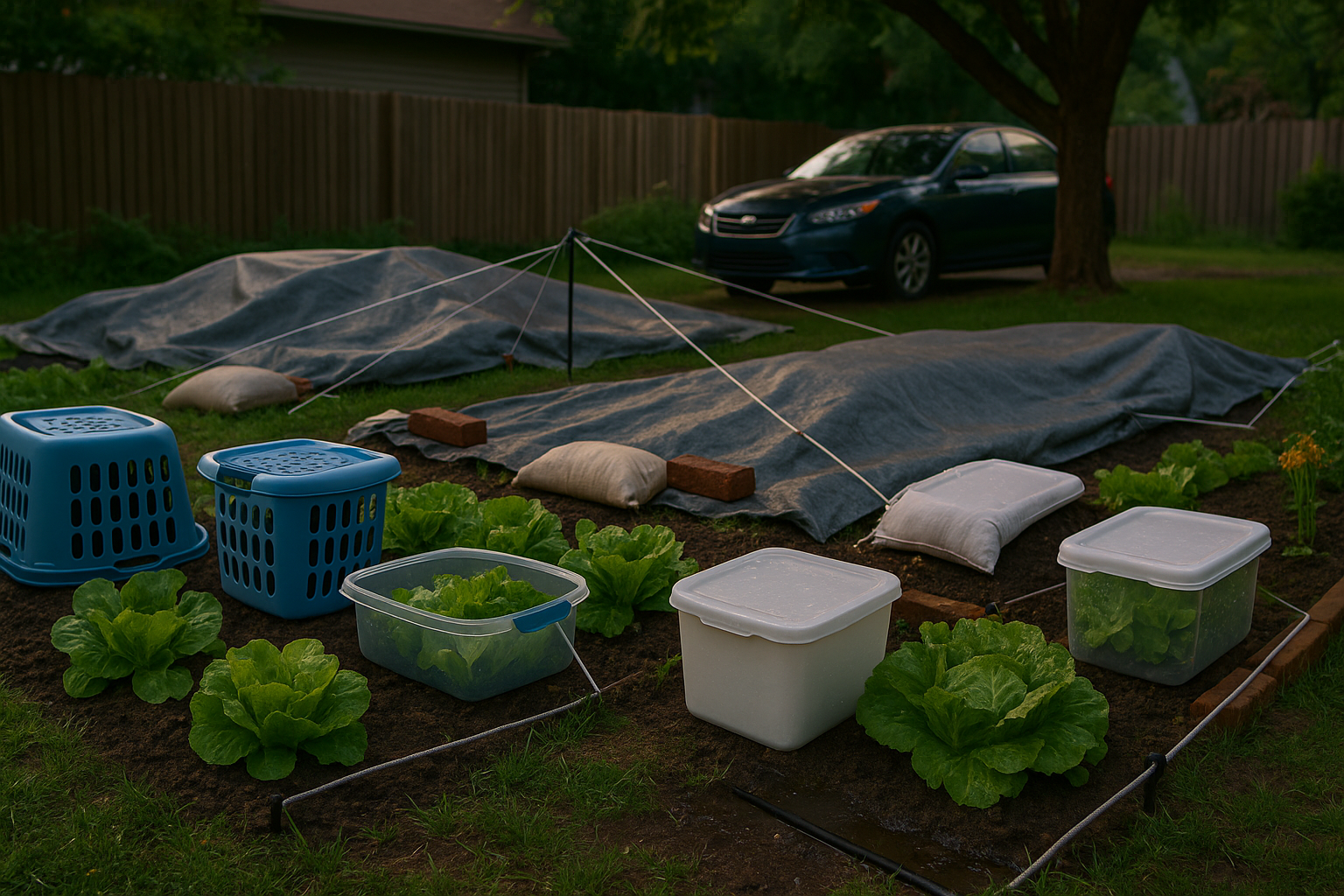
When a storm rolls in unexpectedly and you don’t have proper shields for your car, garden, or outdoor furniture, getting creative can go a long way in limiting damage. Overturned storage bins or large plastic laundry baskets can be lifesavers—just place them over vulnerable plants or small outdoor items to absorb hail impact.
For larger areas, stretch heavy tarps or thick blankets over prized possessions, securing the corners tightly with sturdy garden stakes, bungee cords, or even bricks if stakes aren’t available. To anchor these makeshift covers against gusty winds, fill old pillowcases or shopping bags with dirt or rocks and tie them to each tarp corner—extra weight keeps everything in place.
When covering your car, avoid using thin or lightweight materials alone, as winds can easily whip them away or shred them. Layer whatever padding you have—beach towels, rugs, cardboard—beneath a heavy tarp and tightly secure everything with rope threaded through grommets and tied to your car’s wheels or undercarriage. If you’re worried about weak tie-downs, check seams and knots for slippage and reinforce as needed.
Finally, if hail is on the way and you truly run out of supplies, try parking your vehicle beneath a sturdy tree canopy or next to the side of a building opposite the prevailing wind to minimize direct impact. Preparedness can make a huge difference, but these quick DIY fixes will help when you need to act fast and improvise with what’s on hand.
Soil Care
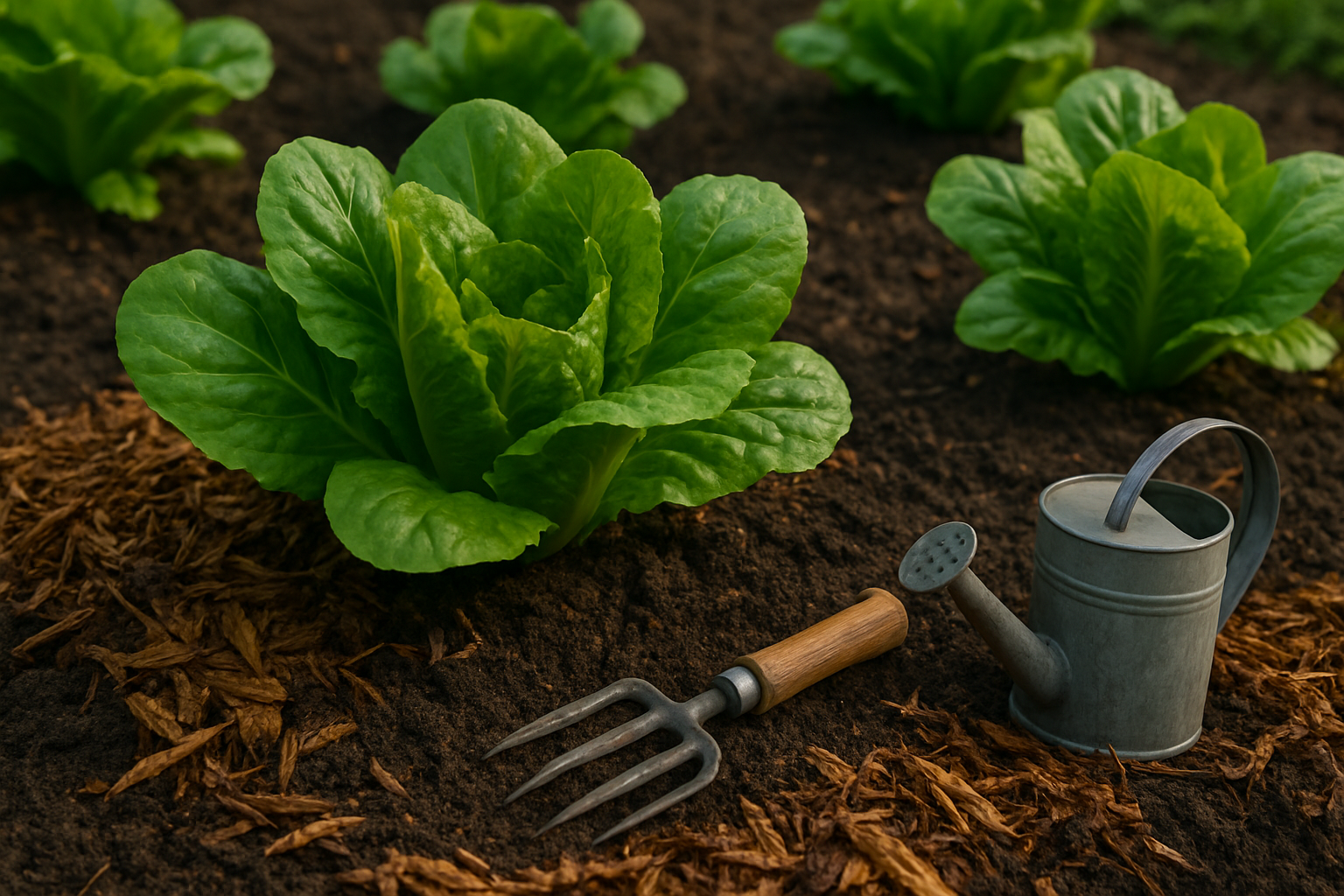
Protecting your lettuce patch during heavy rainfall starts with proactive soil care focused on preventing both erosion and root rot. Mulching is one of the easiest and most effective ways to shield your soil. Apply a thick layer of organic mulch—such as straw, shredded leaves, or grass clippings—around your plants. This buffer slows water runoff, reduces erosion, and keeps soil from splattering onto delicate lettuce leaves.
Alongside mulching, regularly mixing in organic matter like compost or well-rotted manure helps build healthier, more porous soil that drains better and resists compaction. If your garden tends to puddle, consider creating gentle slopes or raised beds, and installing basic French drains or a gravel trench to divert excess water away from the roots.
Early signs of waterlogged soil include yellowing or wilting outer leaves, a sour smell, and visibly soggy earth. To save your lettuce from drowning, gently loosen the soil surface with a hand fork to improve airflow. If possible, carefully lift small plants to drier ground. Remove any mulch temporarily to help the soil dry faster, but replace it as soon as conditions stabilize.
After storms, resist the urge to work wet soil—wait until it’s just damp, then lightly rake to break up surface crusting. Reapply compost and mulch to support recovery, and monitor plants closely for signs of fungal disease or soft, mushy stems. Remove affected leaves promptly to prevent spread. These steps can help your lettuce crop bounce back, ensuring strong roots and healthy harvests even in rainy weather.
Post-Storm Recovery and Lettuce Plant Care
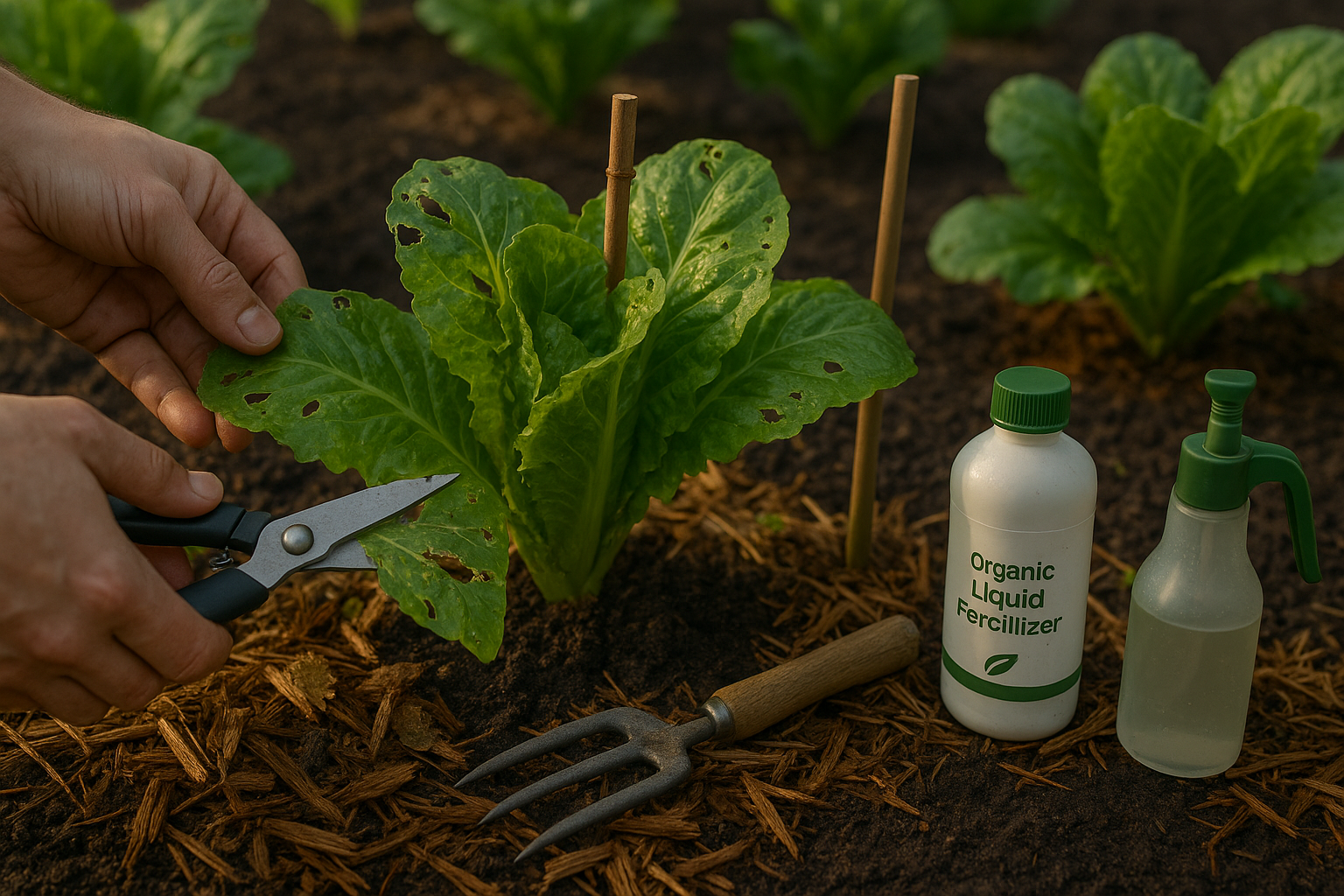
After a heavy rain or hailstorm, start by carefully assessing your lettuce patch—gently lift the leaves and look for broken stems, torn foliage, or signs of disease like soft spots and discoloration. Remove any badly damaged or mushy leaves using clean scissors or garden shears; this helps prevent rot and improves airflow to healthy parts.
For lettuce plants that were knocked sideways, carefully press the soil back around the base and use small stakes or sticks with soft ties to provide extra support until they stand upright again.
Once visible wounds are cleaned, apply a mild liquid fertilizer diluted to half strength to reduce stress and jumpstart recovery, but avoid over-fertilizing as this can burn weakened roots.
If damp conditions persist, consider a gentle organic fungicide spray—especially if you notice gray mold or other fungal symptoms starting.
Plants that are completely flattened or have destroyed growing tips likely won’t recover; pull them out and re-seed with quick-maturing lettuce varieties like ‘Buttercrunch’ or ‘Little Gem’ to salvage your harvest window.
Mulch lightly with straw around recovering plants to prevent soil from splashing onto leaves and to maintain consistent moisture.
Lastly, keep a close eye on new growth, water early in the morning so leaves dry quickly, and pinch outer leaves regularly to encourage fresh, tender growth—helping your crop bounce back faster from even the roughest weather setbacks.
Proactive Tips for Long-Term Lettuce Resilience
Building long-term lettuce resilience in your garden requires a proactive and adaptive approach, especially in regions prone to unpredictable weather. Start by practicing succession planting—sowing lettuce seeds every two to three weeks—to ensure fresh crops are always growing. This minimizes the impact if one planting suffers from a storm.
Opt for hail-resistant varieties, such as iceberg or romaine, which have thicker leaves and are more likely to withstand harsh weather compared to delicate butterhead types. Keep protective gear handy, like row covers, low tunnels, or even simple buckets or bins, so you can quickly shield your lettuce if a sudden hailstorm hits.
Another smart strategy is documenting each storm event and the damage (or lack thereof) it causes—keep notes or photos in a gardening journal. Over time, patterns will emerge, and you’ll better understand which weather events pose the most risk and how effective each protective method is.
Don’t be afraid to experiment with new solutions every season, whether it’s testing different fabric weights for covers or trying out a new planting schedule. Most importantly, share what you learn with other gardeners in your area, either in person or online. Local knowledge is invaluable, and your experience could save someone else’s harvest.
By combining practical strategies, careful record-keeping, and community collaboration, you’ll build a resilient lettuce patch that thrives year after year—no matter what the weather throws your way.
